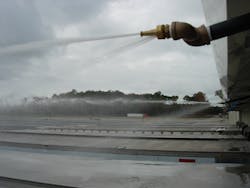Each year, employees of distribution centers and other shipping facilities are faced with a grueling task—working inside a docked semi truck trailer. In many cases, these trailers have been left sitting on the lot for days or weeks before they’re brought to the loading area. Inside, trailers become like ovens, trapping in radiant heat from prolonged exposure to the sun. Temperatures can reach in excess of 130°F.
Two methods have traditionally been used to deal with this condition. Some facilities have tried mounting portable A/C units at each dock door. Employees at the opposite end of the trailer will feel little relief due to the unit’s inability to “throw” the cold air that entire distance.
High velocity dock fans are a more popular method for purging a trailer of hot air, but the air itself is not cooled. Also, this circulation of air will initially blow the excess heat from the trailer back into the loading area. In order for the fan to work more efficiently, more must be done to prevent the heat from penetrating the trailer’s interior.
Enter Evaporative Cooling
Evaporative cooling dates back to the ancient Egyptians. It relies on the basic premise that the evaporation of a liquid (usually water) will carry heat away from a given structure. Our bodies perform evaporative cooling every time we sweat. When the perspiration on the surface of our skin evaporates, it removes much of the heat we have generated internally. This process helps us maintain a normal core temperature during an increased activity load.
The next logical question becomes how to harness the cooling effects of evaporation to bring relief to an employee working inside a trailer. To keep temperatures low inside, evaporation should be used to prevent its outside surfaces from getting hot. Doing so creates a “barrier” from the sun’s radiant heat, blocking it from warming the interior airspace. Since nearly 70% of this generated heat load emanates from the trailer’s roof, it will be our focal point. Employing evaporation on the roof of the trailer will absorb the greatest amount of solar heat energy, and thus maintain a lower interior temperature.
Evaporative Trailer Cooling
The benefits of evaporation, while effective, are only temporary. In order to consistently maintain a lower temperature inside the trailer, a system must be in place to facilitate evaporation at regular intervals. Ideally, this system would cover the trailer roof with a thin film of water and allow for evaporation. This process would automatically repeat itself in timed cycles throughout the workday. These are the basic principles of an evaporative trailer cooling system.
A spray assembly externally mounted above each dock door consists of an electric solenoid valve and spray nozzle. It periodically delivers a half gallon of water to the trailer’s roof over a 6-7 second spray period (an additional line may be needed to connect the assembly with a main water source). The water amount and spray time are designed to maximize the evaporative effect with minimal runoff.
Control schemes will vary in complexity depending on the size of the system and available water supply pressure. For large distribution centers, programming may group doors together in spray “zones.” This means the simultaneous activation of multiple spray assemblies to ensure the correct dwell time between cycles.
There are two additional aspects of the control scheme designed to prevent unnecessary use of water. First is the inclusion of a thermostat, which only allows the system to activate when complete evaporation is possible. Functionality will be restricted during rainstorms or when ambient temperatures do not permit total evaporation within the allotted dwell time.
Another important water saving feature is for a spray cycle to occur only when a trailer is present. To accomplish this, a proximity sensor is mounted directly beneath the spray nozzle at each dock door. For larger systems with multiple doors per “zone,” these sensors are especially critical, as they prohibit a spray cycle at any door within the zone where no trailer is present.
Effects of Cooler Trailers
The result of evaporative cooling in a trailer is lower interior temperatures—as much as a 40°F drop from the peak. Subsequently, a trailer sprayed in continuous regular cycles will remain within ten (10) degrees of ambient temperature. These reductions have a direct impact on employee safety. A cooler trailer mitigates the likelihood of a heat stress injury, saving hours of work time missed and thousands in medical costs.
In addition, a cooler working environment translates into greater efficiency. Trailers may be loaded or unloaded at a faster pace; hydration breaks become shorter and less frequent.
While employee health and safety are paramount, there is a secondary advantage to cooler trailers. By maintaining a narrower temperature range, heat sensitive products can avoid damage. Large retailers with vast distribution networks could realize savings in the hundreds of thousands to millions of dollars each year, covering the initial cost of system installation.
Distribution and shipping facilities continue to remain the lifeblood of a consumer centric economy. But ask any employee who works there and they’ll tell you: few things are more arduous than working inside the sweltering confines of a semi-trailer. However, a well-designed evaporative spray system can provide a low cost, low maintenance solution.
John D. Strait, III is a product specialist at Patterson Fan Company (www.pattersonroofcooling.com).

